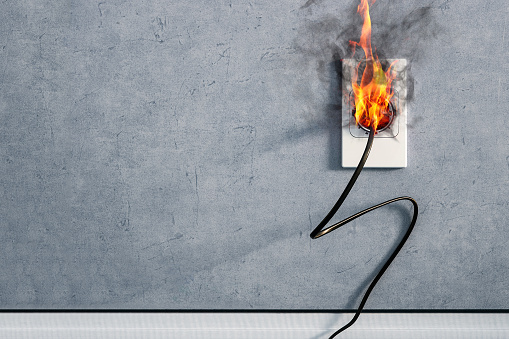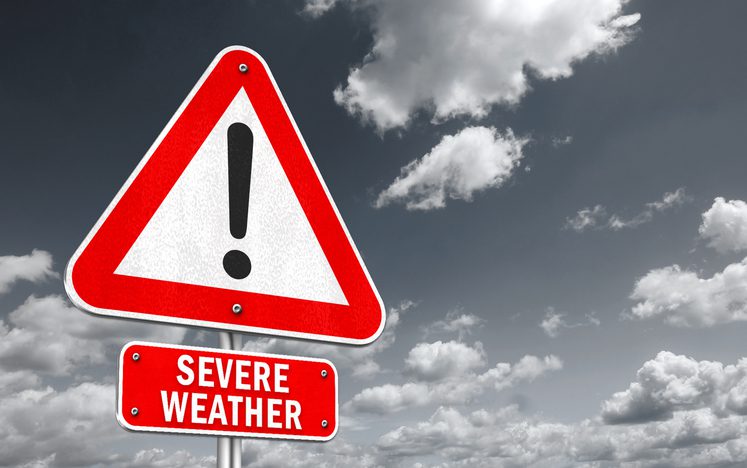Most homeowners know the drill for reducing the risk of a house fire: They keep a smoke detector on each floor and make sure they are all in good working order at least twice a year. They closely monitor cooking, candles, wood stoves and fireplaces. They also refrain from smoking indoors. Matches and lighters are also stowed away where children cannot reach them.
Although all these precautions are an excellent start for promoting fire safety at home, they don’t necessarily protect you from every fire hazard. Here are 10 home fire hazards you might not realize you have, and how to safely use, store or dispose of each item to reduce the risk of fire.
1. Worn Electrical Cords
The electrical cords on any appliances that you frequently move—such as your vacuum cleaner or power tools, or even your laptop—can end up taking a great deal of abuse. Although power cords have no expiration date, they can wear out over time as they are used and abused.
For instance, the insulation around the power cord can wear away, either from the cord’s overheating or through misuse. If you’ve ever been guilty of pulling the vacuum cord out of the outlet by the cord itself rather than the plug, you may have weakened the insulation that surrounds the electrical cables. Similarly, electrical cords that run through high-traffic areas may lose their insulation as they are repeatedly stepped on. Cords that get caught or pinched between heavy furniture can see the same kind of damage.
These cords that have lost their insulation can potentially electrocute you, not to mention the fact that they are a serious home fire hazard.
How to Protect Your Home
If any appliances or extension cords in your home get hot to the touch or show signs of wear, do not use them. You can recycle worn extension cords at your local Best Buy. You can find safe and environmentally friendly ways to dispose of old appliances through the EPA’s Responsible Appliance Disposal program.
When it comes to extension cords, remember they are temporary solutions vs permanent fixes. Extension cords should not be used long-term to run appliances where the existing cord is inadequate for the power required. They also should not be relied on in homes with outdated wiring. For example, using an extension cord so you can plug a 3-prong item into a 2-prong outlet.
You can prevent your cords from wearing out in the first place by:
- Keeping cords out of the path of any foot traffic
- Not forcing cords into spaces that may pinch or crimp them
- Never using staples or nails to attach cords to a baseboard or wall
Finally, you should never run a cord under a rug or between a mattress. This prevents the cord from releasing heat and keeps it out of your sight, so you are less likely to notice if a problem develops.
2. Recalled Appliances
Even if your appliances have intact cords, they may still pose a fire threat to your home if they have been recalled. Some of the most recalled appliances include:
- Microwaves
- Lamps
- Indoor generators
- Washers and dryers
- Ovens
- Lamps
- Computer batteries
How to Protect Your Home
It’s a good idea to periodically check the Consumer Product Safety Commission’s list of recalled items to make sure nothing in your home appears on the list. Make looking over this list part of your twice-yearly fire safety routine when you’re also checking the batteries in your smoke detectors. If you discover that one of your appliances has been recalled, contact the manufacturer to determine the proper next steps for dealing with the issue.
3. Space Heaters
Having a space heater in the winter can often mean the difference between chattering teeth and cozy warmth. But because space heaters are portable, many users will place them too close to combustible items—like curtains, furniture, rugs or blankets.
Coil space heaters are especially dangerous, because the coils are so hot that they can quickly ignite anything flammable that comes into contact with them.
How to Protect Your Home
If you use a space heater in your home, make sure it is kept far away from any items that could catch fire. Also, the radiator-type space heaters that diffuse heat over the entire surface of the appliance are safer than the coil heaters, although you must keep both kinds away from flammable items. Finally, make sure your space heaters have been safety tested and UL approved. Be sure to follow proper usage instructions. For instance, you should never leave a space heater unattended. It also should not run all day.
4. Clothes Dryers
According to the National Fire Protection Association (NFPA), local fire departments respond to an estimated 15,970 home fires involving clothes dryers or washing machines each year: 92% of these fires involved the clothes dryer.
So, what is it about clothes dryers that make them such a potent home fire hazard? Accumulated lint. This material is very flammable, and it can build up both in the lint trap and in the venting system. Since dryers use heated air to work, and exhaust that air through the vents, any lint in the system has the potential to ignite.
How to Protect Your Home
Cleaning the lint trap of your dryer before each use can do a great deal to prevent fires. However, that is not the only cleaning you need to do to protect yourself from this home fire hazard. Experts recommend having your dryer vents professionally cleaned every 12 to 24 months.
While hiring a professional is best, there are DIY dryer vent cleaning kits that can help keep you safe between cleanings.
In addition, know the warning signs that your dryer vents may need cleaning, including:
- An extra hot dryer
- Clothes that take a long time to dry
- A burning smell when you run the dryer
5. Loose Outlets
If plugs keep falling out of an outlet, it’s more than just a nuisance—it’s a major home fire hazard. That’s because the contacts in the wall have worn down, meaning they are not able to securely grip your plug, causing a missed electrical connection. This is a missed connection can cause electrical arcing (a spark wherein electricity jumps from one place to another), which can cause a fire.
How to Protect Your Home
Replacing loose outlets is a simple job for a professional electrician. In general, you can expect to spend $8 to $10 per outlet, although most electricians will have a minimum charge for your bill. If you are committed to DIY, there are many sites that will walk you through the process—but it’s always better to get professional help when you’re dealing with electrical work.
6. Oily Rags and Clothes
Changing your own oil is a great way to save money, but it can increase your risk of a home fire. That’s because oil-soaked rags can spontaneously combust—without any spark to ignite them. The same goes for clothes that get oily, which is common in many professions.
This is a risk whether the oil is from your car’s engine, from oil-based paint, from varnishes or from the vegetable oil you use in the kitchen.
Here’s how it works: The rags will slowly heat to the oil’s ignition point via oxidization. Oxidization causes a substance to release heat, and, if there is no place for the heat to dissipate—because the rags are in a pile, for instance—then the temperature will rise to the oil’s ignition point, starting a fire.
How to Protect Your Home
When you have oily rags that you wish to reuse, hang them up to dry outside or in a well-ventilated room before laundering them. This will allow the heat to dissipate safely as the rags dry and help prevent spontaneous combustion.
If you plan to dispose of oil-soaked rags, make sure you place them in a container with a tight-fitting lid, then fill the container with water. It is safest to use metal containers, but you can use a zip-top plastic bag as an alternative. From there, contact your garbage disposal service to find out how to properly dispose of the rags.
7. Excess Sawdust
Amateur woodworkers and home improvement DIYers know that sawdust is the inevitable result of their projects. Unfortunately, it is hazardous to allow sawdust to collect.
Not only does sawdust ignite and burn much more easily than whole pieces of lumber, but sawdust in the air ignites even more easily. Even a fine layer of sawdust poses a significant home fire hazard.
How to Protect Your Home
Make sure you regularly clean up any sawdust you create using a vacuum specifically made to collect combustible dust. Once the dust has been vacuumed up, it can be bagged in a plastic garbage bag and disposed of in the trash. If you plan to make a serious hobby of woodworking (or other sawdust-generating activity), invest in a good dust-collection system.
8. Household Chemicals
Your home is full of various chemicals that are potential fire hazards, including:
- Aerosol cans of cleaning solutions under your kitchen sink
- The bottle of nail polish remover in the bathroom cabinet
- Ammonia and bleach in the laundry room
Thankfully, unlike oily rags, these types of chemicals are not likely to spontaneously combust. Instead, they can sometimes emit combustible fumes or can catch fire if used too close to any kind of open flame or spark.
How to Protect Your Home
Make sure that you keep combustible household chemicals well away from anything that can cause a spark, including:
- Outlets
- Candles
- Fireplaces
- Lit cigarettes
9. Crumbs in the Toaster
Most people are not surprised to learn that 44% of all home fires in the U.S. are from cooking. After all, fire (or heat) is a necessary component of cooking. However, while you are perfectly aware of the potential fire hazards of using the stove and oven, you might overlook the possible danger lurking in the humble toaster.
Toasted bread generates crumbs, which can accumulate in the bottom of your toaster. These combustible crumbs can ignite during normal toasting and set the appliance on fire.
How to Protect Your Home
Most toasters have a removable tray on the bottom for easy cleaning. Make sure you clean out the tray regularly to mitigate this home fire hazard.
10. Non-Dairy Coffee Creamer
This innocuous grocery item may be your preferred coffee additive, but it is also a highly flammable substance. In fact, when powdered coffee creamer is suspended in the air, it is potentially more flammable than flour or rice dust. Everyone from YouTube stars to the Mythbusters team have used coffee creamer to create fireballs to show off its flammable nature.
The good news is that it would require much more creamer than you use in a normal cup of coffee to put yourself at risk. However, it’s important to recognize just how flammable your non-dairy coffee creamer is, just in case.
How to Protect Your Home
Keep your coffee creamer away from open flames—and if you should ever drop a whole container of the stuff, consider using a vacuum for combustible dust to clean it up.
Enjoy a Fire-Safe Home
By becoming aware of these 10 common—and not-so-common—fire hazards in the home, you can help protect both your family and your property. It’s also critical to know what you’d do in the event of a fire—whether it’s establishing your evacuation plan or having a fire extinguisher at the ready.
Want to help the kids in your life learn about home fire safety? Check out our Junior Fire Marshal program and help them:
- Join a free virtual fire safety event
- Explore online home fire safety lessons
- Download fire safety materials







My TV remote felt warm. A few minutes later it was hot! I removed the hot AA battery. The other one was cool. It took about 45 minutes for the hot one to cool down. I asked google if AA batteries could ignite. Answers said if they were stored incorrectly or touching other terminals. Nothing was said about one that was installed and in use for about 3 months before the incident. Be aware.
I really appreciate it all the facts that I didn’t know and learned a lot from it and appreciate you reporting it because it has very helpful and knowledgeable and safe to know about I’m glad to know that I will sharing it with family and friends
Very helpful thank you for the publication of all of the information in 10 steps to protecting your home against fire
Thanks for the hints
Thank you for the safety tips.
I appreciate receiving home safety information.
Good stuff thanks for reminding us !!
A volunteer firefighter told my mom to stop using the coffee maker on auto start, like when you want it to brew before you get up. He said they responded to several fires from those.
I will take any help you can offer. Thank you
House fires have been rampant in our city so my dad is looking into more ways we can have protection. Thanks for mentioning some hazards we need to look out on such as non-dairy creamer that is actually highly flammable. I wonder if there are some services we could also call to do some safety home installments.
Fortunately, I don’t seem to have the problems you mentioned, though I will clean out the crumb tray in my toaster and become more alert in the future. Thanks for the information.
Thanks for the excellent information.
In addition to cleaning out bread crumbs from your toaster, you should also leave it unplugged after use. After years of usage, the inside of a toaster is covered in oils that can cause the heating element contacts to touch, effectively turning it on. The heating elements will remain hot and can eventually set your kitchen on fire.
All of your cautionary points are so well taken.
It’s good to go through a list of things to become aware of things to check.
KF
We moved into a senior citizen cottage after owning a home for 49 years. This is a new cottage. My dryer took 200 minutes to dry the clothes. I had to put bath towels out on the patio to dry. I reported this problem to the maintenance person. I was told that many people had the same problem. I finally wrote to the person in charge. She made sure that all the dryer vents were cleaned. Plastic was found in my vent. It could have caused a fire. My dryer works now. I think it is important to have a calendar that tells you about yearly checkups or items such as furnace filters, bug spray, etc. The safety of their clients is important.
Keep new batteries in original containers until used. Do not let new batteries roll around in desk drawers. They could spark and cause a fire especially around paper. Than you
Some of my electrical outlets don’t work. Is this a fire hazard? Do I need to get my entire condo re-wired? I’m looking for the cheapest safe solution as a retired senior.
I have three other safety ideas: 1) NEVER plug two or more electrical power strips together, and never overload one with electrical items that draw a lot of amps or watts like heating devices or other small appliances. 2) Know the formula: volts times amps = watts. Most home circuit breakers are rated at 15 amps for each outlet. And most outlets are 110 to 115 volts. That means if you have a space heater that is rated 1500 watts, 1500 divided by 110 = 13.63. That doesn’t leave a lot of safety margin for total amp capacity. That appliance alone hogs most of the circuit breaker’s amp capacity. Do not plug anything else into that outlet. 3) When using an extension cord say for outdoor electric trimmer work, use a heavy duty extension cord (available at most hardware stores), NOT a regular indoor one. The more copper inside the extension cord, the less hot it will become and pose a fire hazard.
Mr. Franklin…Thank You for your excellent advise….
It may seem hard to believe, but if you make your own humming bird nectar, be careful that it doesn’t boil over as sugar is quite flammable and the mixture will start on fire if it spills onto the burner. Had to replace the backsplash an ventahood due to just that.
just heat the water and then stir in sugar. I heat my water in microwave, it kills and bad stuff in water
my biggest safety bonus is our whole town is surrounded by floded rice fields.
I just read your article and wanted to say thanks. It is a great reminder that we can be our own worst enemy. I’m glad you are making an effort to keep things safe at home for your family!
Thanks again for all of the hard work.
I have a serious appliance situation in that a hardwood floor refinisher left kitchen door open and stripped 5 hardwood floors near. He proceeded to use a leaf blower to “take care of the dust” which caused the appliances and kitchen and home to be covered in 30 yr old sawdust and floor contents. Our toaster burst into flames.
I can not find anyone who can appliance clean and local gas provider does not provide service for this. Their recommendations failed. They are all Whirlpool including a gas stove. No correct answer online or on phone for days.
Common sense says replace all as I can swipe sawdust from inside washer, inside oven drawer.
Any recommendations very much appreciated.
Thanks for this fire protection hazard tips. We should be careful specially if our home has lots of furniture.
This is excellent information’ I have been going through many of these problems. I have thrown out several appliances that had cords overheating. I have had chords falling out of electrical outlets. I had a licensed electrician do an inspection and the report was overwhelming.
I was a Large Loss Adjuster at the Hartford for 7 years. one of the most common fires is leaving candles unattended. Second, extinguish all smoking materials and put them in a can away from the home. Third, do not clean out your wood stove and place ashes in a paper sack or plastic bucket. Place the bucket away from the house, not in a trash can under your eaves. Away from the house, I don’t care how long since your last fire. Away from the house!
Thank you Jim for your expertise!
This made me realize which other things are fire hazardous at our home. Time to inspect them and keep in optimum condition plus be prepared in case of failure.